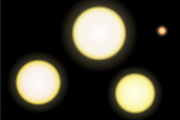Viewings: 6103

Scientists suggest that many binary star systems started life as a compact triple stars, two of which were later United in order to cast off the third. That's the law - the third is superfluous even in space. Apparently, the same fate awaits one of the stars of star Alliance, known as alpha Centauri.
Among the many multiple star systems are those where the stars go around each other, although they may mutually be farther away than Pluto from our Sun, and is the best example is easily detected: this is a multiple of the system, which includes alpha Centauri. Binary close the system consists of the star alpha Centauri, and its neighbor under the letter In, and third, weakly shining individual stars, remote from binary Alliance one-fifth of a light-year and moving in elliptical orbit.
So, alpha Centauri is a set of three separate bodies. Of modern computer simulation of multiple star systems astrophysics get interesting results. In Nature it is reported that many binary systems started life as a compact triple stars, two of which combine to cast away the third!
If rejected, the star remains bound by gravity in the system with other two - as in the case of alpha Centauri - remains close binary pair with a distant star, rotating around a Central pair on very elliptical orbit. The stability of such systems is guaranteed, if distant star is kept away from close pairs.
Observations were made VLT-interferometer (VLT - the Very Large Telescope). Superior measurement accuracy was achieved using two 8.2 meter telescopes of the Observatory Paranal (ЕSА)situated one from another at the distance of 102,4 m, they provide high accuracy of measurements. Staff from the Geneva Observatory (Switzerland) shortchanged data and first got the exact size of Proxima, its angular diameter is 1.02±0.08 corner milliseconds! For comparison - this is the size of the astronaut on the surface of the moon as seen from Earth.
Proxima Centauri is 4.22 light-years from the Sun, the closest to us of all known stars, the object of the 11-th magnitude in the southern constellation of Centaurus. It was opened only in 1915. Scottish astronomer Robert Indecom (1861 - 1933). The same bright star alpha Centauri, And (of 4.35 light-years from the Sun, called Rigel (leg) Centauri - the brightest star of the constellation. It is very similar to our Sun, but is farther Proxima.
Alpha Centauri, And has been known since ancient times, being fourth on the brightness of a star in the night sky. Bright star is alpha Centauri, a and b combined in a close binary system, they are separated by a distance of 23 A. that is, slightly more than the distance from the Sun to Uranium. Proxima is very far from couples: at a distance of 13 000. E. (or 0,2056 light years, which is 400 times larger than the distance from the Sun to Neptune).
All the stars go around a common center of mass. However, the period of circulation of Proxima Centauri millions of years so it will stay for us "nearest", and only through 9000 years closest to the Sun will be different light. They will be the star of Barnard - she quickly moves in the direction of our system.
Proxima Centauri is the smallest of the three stars, it seven times lighter than the Sun, and its surface temperature is 3000 degrees, she dimly lit. Its weight is barely enough to maintain in the depths of the stars of the process of synthesis of helium from hydrogen. The brightness of Proxima 150 times less than the Sun. The star with such a small mass physical conditions in the depths have a lot in common with what is happening inside these giant planets like Jupiter. There is an assumption that the planets near such stars may even be life.
Proxima Centauri is located on the border between the real stars, brown dwarfs and planets. The mass and diameter of Proxima Centauri is about 1 / 7th of the mass and diameter of the Sun. This star is 150 times more massive than Jupiter, but only 1.5 times larger. If its mass was two times smaller, it could never be a star, the hydrogen in its depths simply could not catch fire. Then it would be a brown dwarf, not a full-fledged star.
For a star like the Sun, the substance of which behaves as an ideal gas, the stellar size is proportional to the mass. However, for such stars as Proxima Centauri, become extremely important quantum effects, and their stellar matter "degenerates", it has to resist compression, because the nuclear reaction to make it longer able. In subjects with half the mass of Proxima Centauri (or easier) the substance is completely degenerated, and their amount does not depend on the mass.
And suddenly our own Sun is born with the other two, but it was thrown away in a cataclysmic variable star orbits at a time when there was a formation of the close binary system? Maybe it tried to break the Alliance, and the happy pair "fired" it by sending in the distant exile. Well, that's the law - the third always superfluous. Even in the vast depths of space ...
















